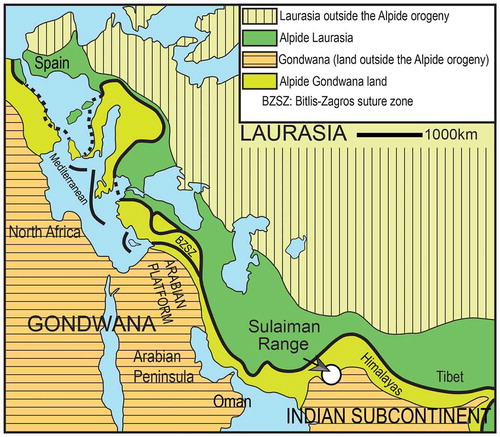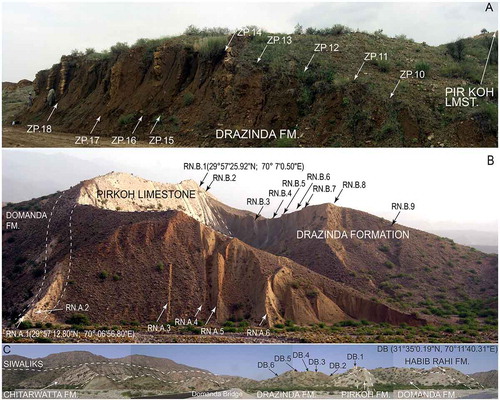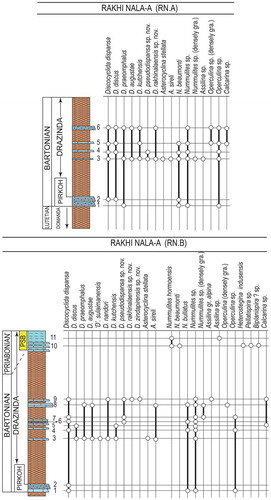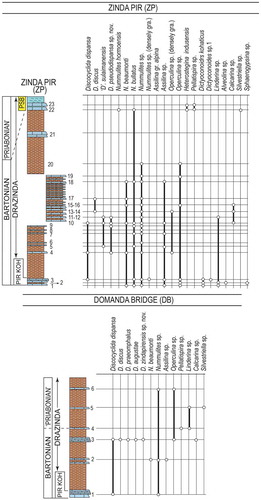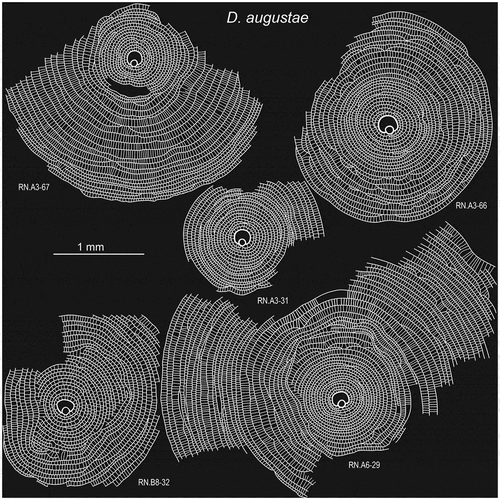Abstract
The Pirkoh and Drazinda formations in the Sulaiman Range, central Pakistan, yielded assemblages of (early) Bartonian orthophragminids, characterized predominantly by discocyclinids with a significant number of species probably endemic to Indian Subcontinent. The rarity of Asterocyclina and the absence of Orbitoclypeus and Nemkovella are noteworthy. Ten species of Discocyclina Gümbel and two species of Asterocyclina Gümbel, referable to the Shallow Benthics Zone (SBZ) 17 are described for the first time from Pakistan. The discocyclinids, i.e. Discocyclina praeomphalus, D. sulaimanensis, D. kutchensis, along with the new taxa established here, D. zindapirensis sp. nov., D. rakhinalaensis sp. nov., and D. pseudodispansa sp. nov., seem to be confined to the Indo-Pakistani region (Eastern Tethys). The Discocyclina dispansa, D. discus, D. nandori, and D. augustae lineages known from Western Tethys are also common in the Indian Subcontinent, as are asterocyclinids, such as Asterocyclina sireli and A. stellata. The upper part of the Drazinda Formation (‘Pellatispira beds’), referable to latest Bartonian and/or the early Priabonian, is poor in orthophragminids and is characterized by the occurrence of reticulate Nummulites, Heterostegina, Pellatispira and Silvestriella. The records of ‘Lepidocyclina of Caribbean affinity’ with large embryons from the Eocene of the Indian Subcontinent correspond to misidentified Discocyclina discus.
1. Introduction
The Upper Paleocene-Eocene platform/shelf deposits along the margins of Gondwana and Laurasia, from Europe (Western Tethys) to the Indian Subcontinent and China (Eastern and Central Tethys) () are characterized by the widespread deposition of carbonate units with diagnostic biota. Larger benthic foraminifera (LBF), such as nummulitids, orthophragminids, alveolinids and rotaliids, constitute the dominant faunal element in these deposits (Afzal, Wıllıams, Leng, Aldrıdge, & Stephenson, Citation2011; Hottinger, Citation2014; Racey, Citation1995; Schaub, Citation1981; Serra-Kiel et al., Citation1998; Zhang, Willems, & Ding, Citation2013), which are generally referred to as ‘Nummulitic limestone’. The middle Eocene shallow-marine deposits with prolific development of LBF are exposed in some parts of the Indian Subcontinent: in the Sulaiman and Kirthar ranges in Pakistan, Kutch and Cambay basins in western India, and in the Assam-Meghalaya regions in eastern India (Eames, Citation1952a, 1952b; Nagappa, Citation1959; Nuttall, Citation1926; Özcan, Saraswati, Hanif, & Ali, Citation2016 and references therein; Özcan et al., Citation2016; Samanta, Citation1968; Samanta & Lahiri, Citation1985). In the Sulaiman Range, to the west of Himalayas, the middle Eocene deposits, informally named ‘Discocyclina beds’, are known for the abundant occurrence of orthophragminids and nummulitids and also for the remains of sea cows and archaeocete whales, described from the Drazinda Formation (Gingerich, Arif, Bhatti, Anwar, & Sanders, Citation1997 and references therein). Although the Bartonian orthophragminids from the Kutch Basin and Assam-Meghalaya region in India have been fairly well studied at generic and species level, no thorough account of this group from Pakistan has been presented yet (Afzal, Asrar, & Naseer, Citation1997; Afzal, Williams, & Aldrıdge, Citation2009). Previous studies from the Bartonian Pirkoh and Bartonian-Priabonian Drazinda formations (equivalent of the obsolete Kirthar series) in the Sulaiman Range reported the occurrence of a few species of Discocyclina Gümbel, 1870 without any record of Nemkovella Less, Citation1987, Orbitoclypeus Silvestri, 1907, and Asterocyclina Gümbel, 1870. This is in contrast to the diverse orthophragminid assemblages from coeval deposits in the peri-Mediterranean region (Western Tethys), where more than fifteen species are known in the Bartonian (Ben İsmail-Lattrache et al., Citation2014; Less, Citation1998). The Pirkoh and Drazinda formations offer a unique opportunity to characterize the Bartonian orthophragminids from this part of Tethys that may help integrating the current shallow benthic zonation and the correlation of Tethyan shallow-marine deposits. Our aim here is to describe the orthophragminids from the Pirkoh and Drazinda formations in detail. The nummulitids and other LBF, which are in many horizons, will be published separately.
2. Geological setting and stratigraphy
The Sulaiman fold belt is a lobate structure in East Pakistan that constitutes a major part of the Lower Indus Basin to the south of the suture zone of the India-Eurasia collision (Kazmi & Rana, Citation1982; Shah, Citation2009) (Figures and ). A marine transgression in middle Eocene influenced a large area including the Lower Indus Basin, leading to the deposition of a thick sequence of shallow-marine carbonates and clastics. These deposits preserve a record of marine mammals (archaeocete whales), decapod crustaceans and abundant LBF (Afzal et al., Citation1997; Charbonnier et al., Citation2013; Gingerich, Ul-Haq, Khan, & Zalmout, Citation2001; Schweitzer, Feldmann, & Gingerich, Citation2004). The significance of the marine Bartonian and Priabonian deposits in the frame of the tectonic evolution of the region is, however, debated. According to Kazmi and Abbasi (Citation2008), marine middle to upper Eocene sediments in the Sulaiman fold belt and their correlative units in the Kirthar belt were deposited in a post-collisional epicontinental sea. In contrast, these deposits underlying the continental Oligocene sequence have been also interpreted to record the final stages of the diachronic closure of Tethyan seaway in Priabonian times in the Lower Indus Basin (Kazmi & Abbasi, Citation2008).
Figure 2. Location of Sulaiman Range in Pakistan to the west of Himalayas (A), simplified geological map of the Sulaiman Range and position of the studied sections (B), and generalised stratigraphic sections and sampling points in the Pirkoh and Drazinda formations (C). Geological map is simplified from Kazmi and Rana (Citation1982). PSB: Pellatispira beds.
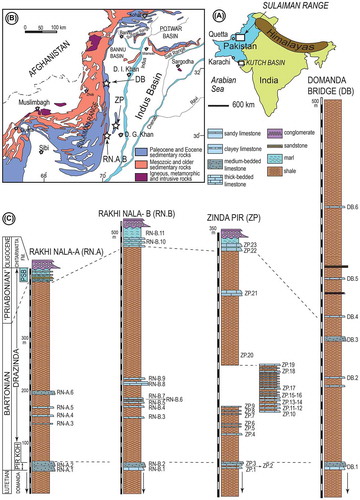
The middle to upper Eocene sedimentary sequence in the Sulaiman Range is subdivided into the Habib Rahi, Domanda, Pirkoh and Drazinda formations, which were collectively named as ‘Kirthar’ by Blanford (Citation1879) (). The historical development of the lithostratigraphic names applied to these units is given in Hemphill and Kidwai (Citation1973), Kazmi and Abbasi (Citation2008) and Shah (Citation2009). The Domanda Formation corresponds to the Lower Chocolate beds of Eames (Citation1952a) and consists of dark-brown and greenish-gray mudstone with subordinate brown sandstone intercalations consisting of limonitic concretions and phosphatic nodules. Bivalves and echinoids occur in some levels. The unit is well known for vertebrates, specifically for archaeocete whales (Gingerich et al., Citation1997, Citation2001), Sirenia and decapod crustaceans (Charbonnier et al., Citation2013; Zalmout, Ul-Haq, & Gingerich, Citation2003), while LBF are very sporadic and not studied at the present work. The thichness of the unit ranges from 150 to more than 300 m in the Sulaiman Range. The Pirkoh Formation is light gray to brown, thinly bedded carbonate unit containing subordinate beds of shaly limestone and dark gray marls. This unit, about 10–12 meters thick, consists of mainly nummulitids, orthophragminids, and scarce alveolinids and forms a persistent ridge in Sulaiman Range (). The term ‘Drazinda Shale Member’ of the Kirthar Formation was introduced by Hemphill and Kidwai (Citation1973) to replace the ‘Upper Chocolate Clays’ of Eames (Citation1952a), who first established a robust Eocene lithostratigraphic framework for the Sulaiman fold belt. The Drazinda Formation, more than 380 and 300 m thick in Rakhi Nala and Zinda Pir respectively, consists of dark-brown to greenish-gray shale and subordinate marl and limestone beds containing LBF, bivalves, bryozoans and echinoids in its lower and middle, and pale yellowish-green Pellatispira-bearing marls in the upper part. Orthophragminids occur abundantly in the lower-middle part of the Drazinda Formation while upper part yields mostly nummulitids, such as Heterostegina, reticulate Nummulites, and Pellatispira. This unit records the final stage of an Eocene marine environment in the region and its outcrops can be traced long distances in the eastern Sulaiman fold belt. The Drazinda Formation is unconformably overlain by coastal deltaic to fluvial deposits of the Oligocene Chitarwatta Formation.
Figure 3. Generalised stratigraphy of Lutetian to Priabonian units in the Sulaiman Range with historical development of lithostratigraphic nomenclature and previous records of orthophragminids and associated LBFs. The studied interval is marked. Z refers to the ‘zones’ described by Eames (Citation1952b).
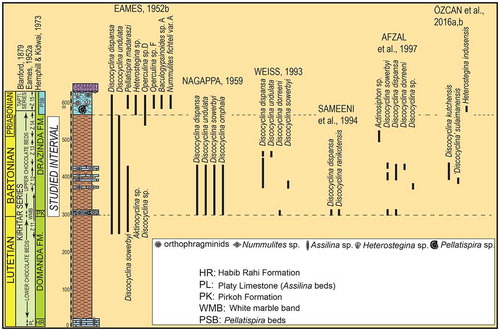
Figure 4. Field aspects of Pirkoh and Drazinda formations. Pirkoh Formation in Rakhi Nala A (A, B), Domanda (H) and Zinda Pir section (I–K), and Drazinda Formation in Rakhi Nala A (C; sample RN.A.4, D; sample RN.A.6), Rakhi Nala B (E–G) and Zinda Pir section (L).
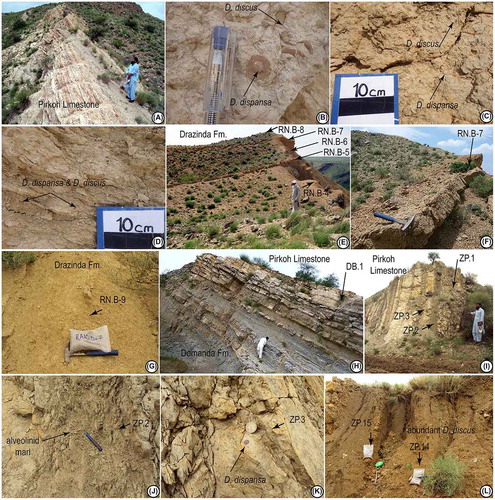
The ages of the Pirkoh and Drazinda formations were previously dated as Middle and/or late Middle and Late Eocene based on calcareous nannofossils (Köthe, Khan, & Ashraf, Citation1988) and planktonic foraminifera (Afzal et al., Citation1997; Samanta, Citation1973; Warraich & Nishi, Citation2003). According to Köthe et al. (Citation1988), the age of Pirkoh and Drazinda formations in the Rakhi Nala section is Middle Eocene to Priabonian based on nannoplankton zones NP 15-16? in the former and 16-19/20 in the latter unit. Samanta (Citation1973) recorded Globorotalia crassata/ Truncorotaloides topilensis, Truncorotaloides rohni and Globigerina officinalis zones in the ‘Upper Kirthar’ Formation in the Rakhi Nala section. Since Samanta (Citation1973) did not follow the conventional lithostratigraphic nomenclature of lithostratigraphic unit at that time, a correlation of these zones to the presently accepted units is not possible. Nevertheless, his data suggest late Middle to Late Eocene age for the succession in Raki Nala Section. Afzal et al. (Citation1997) identified P12/13 and P14 planktonic foraminiferal zones in Pirkoh and Drazinda formations respectively, suggesting a transitional Lutetian-Bartonian age for Pirkoh and (early) Bartonian for the part of the Drazinda Formation below the Pellatispira beds. Warraich and Nishi (Citation2003) identified P12 in Pirkoh and P13-15 planktonic foraminiferal zones in the Drazinda Formation that suggest a Lutetian/Bartonian-Priabonian age for this part of the sequence. The upper part of the Drazinda Formation, the Pellatispira beds, yielded NP18-19/20 calcareous nannofossil assemblages in the Rakhi Nala section suggesting Priabonian age (Köthe et al., Citation1988). The Pirkoh Formation was deposited in the inner to outer shelf, and the bulk of the Drazinda Formation has been deposited in the shelf lagoon and shoal environments. The ‘Pellatispira beds’ of the Drazinda Formation have been deposited in the outer shelf (Abbas, Citation1999).
3. Previous records of orthophragminids in Pirkoh and Drazinda formations
Although orthophragminids have been reported from the Pirkoh and Drazinda formations, only few species have been illustrated (Afzal et al., Citation1997; Nagappa, Citation1959; Sameeni, Ahsan, & Baloch, Citation1994; Weiss, Citation1993). The discocyclinids were identified as Discocyclina dispansa, D. sowerbyi, D. undulata, D. omphala, D. dorreini while asterocyclinids were not reported (). The presence of Actinosiphon, a Caribbean species, was also reported from the Drazinda Formation (Afzal et al., Citation1997). Some orthophragminids with various axial thickening structures, Discocyclina kutchensis Özcan and Saraswati 2016 and D. sulaimanensis Özcan, Ali, Hanif, 2016, were recently described from the Fulra Limestone in Kutch, India and Drazinda Formation in Sulaiman Range (Özcan et al., Citation2016). The Heterostegina in the upper part of the Drazinda Formation (Pellatispira beds) is represented by an endemic species, Heterostegina indusensis Özcan, Ali, Hanif (Özcan et al., Citation2016), suggesting the polyphyletic origin of the genus. The Western Tethyan Heterostegina lineages, such as H. armenica (Grigoryan), H. reticulata Rütimeyer and H. gracilis Herb, were not found in the Drazinda Formation.
4. Materials and methods
The Pirkoh and Drazinda formations have been sampled in three different outcrop areas, Rakhi Nala, Zinda Pir and Domanda Bridge, in the Sulaiman Range to provide the widest coverage of the orthophragminids (Figures and ). The Rakhi Nala A 29°57′12.80′′N,70°06′56.80′′E; 29°57′13.51′′N, 70°7′1.74′′E), and Rakhi Nala B (29°57′25.92′′N,70°7′0.50′′E; 68°40′49.23′′E, 29°57′16.10′′N,70°7′11.20′′E) sections are from the same area west of Dera Ghazi Khan in the Punjab province. The Zinda Pir section (30°20′2.38′′N, 70°29′32.54′′E; 30°19′56.65′′N, 70°29′39.48′′E), located in the Zinda Pir anticline, is ca. 55 km north-east of the Rakhi Nala section. The Domanda Section (31°35′0.19′′N, 70°11′40.31′′E; 31°35′14.43′′N; 70°11′28.78′′E) is located in the north-west of both Rakhi Nala and Zinda Pir sections, and is about 73 km west of Dera Ismail Khan in the Federally Administered Tribal Areas (FATA).
Specimens extracted from the shale, marl and limestone beds were studied for their external features, features in the equatorial layer and axial sections. The oriented sections of megalospheric and (partly) microspheric specimens (A and B-forms respectively) have been prepared through their equatorial layers because the most important taxonomic and evolutionary parameters are observed in this part of the test (Ferràndez-Cañadell, Citation1998; Less, Citation1987; Neumann, Citation1958; Portnaya, Citation1974). The biometric measurements and counts were carried out on equatorial sections of the megalospheric specimens (Less, Citation1987, Citation1998). Eight measurements (in μm) and counts and some qualitative data were used to characterize the taxa (, ). These measurements and counts are: P and D, outer diameter of the protoconch and deuteroconch perpendicular to their common axis; A, number of adauxiliary chamberlets; H and W, height and width of the adauxiliary chamberlets; n0.5, number of annuli within a 0.5 mm distance measured from the deuteroconch along the axis of the embryon; and h and w, height and width of the equatorial chamberlets around the peripheral part of the equatorial layer. Finally, axial sections of megalospheric and microspheric forms have been prepared in order to facilitate specific recognition in rock thin sections.
Figure 6. General test features in Tethyan orthophragminid genera (A) (after Ferràndez-Cañadell, Citation1997; Less, Citation1987; Özcan et al., Citation2016), qualitative parameters (B): a- types of embryon configurations, b- types of the adauxiliary chamberlets, c- different growth patterns of the equatorial annuli, d- types of granules and lateral chamberlets on the test surface, and parameters used in the morphometric description of orthophragminids as illustrated in D. pseudodispansa sp. nov. from sample RN.B9–79 (C). pac: principal auxiliary chamberlets.
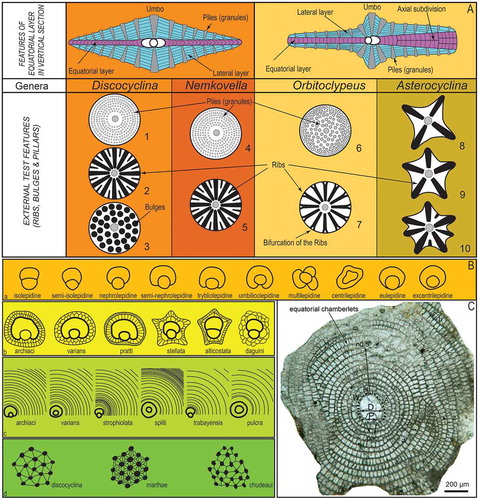
Table 1. Statistical data of orthophragminids from the Pirkoh and Drazinda formations. For the illustration and explanation of the parameters see Figure 6C. N denotes the number of specimens studied in the sample.
5. Distribution of orthophragminids in the Pirkoh and Drazinda formations
Orthophragminids in the Pirkoh and Drazinda formations are represented by Discocyclina and sparse Asterocyclina whereas Orbitoclypeus and Nemkovella were not recorded (Figures and ). The Pirkoh Formation yielded only discocyclinids, represented by D. dispansa (Sowerby, Citation1840), D. discus (Rütimeyer, Citation1850), D. praeomphalus Samanta & Lahiri, Citation1985 accompanied by Dictyoconoides, Nummulites, Assilina, Operculina, Linderina and alveolinids, found only in one level (sample ZP.2) in the Zinda Pir section. Orthophragminids in the Drazinda Formation are more diverse and are characterized by D. dispansa (Sowerby, Citation1840), D. discus (Rütimeyer, Citation1850), D. praeomphalus Samanta & Lahiri, Citation1985; D. augustae Weijden, Citation1940; ‘D.’ sulaimanensis Özcan, Ali & Hanif, 2016, D. kutchensis Özcan & Saraswati, 2016, D. nandori Less, Citation1987; D. pseudodispansa sp. nov., D. rakhinalaensis sp. nov., D. zindapirensis sp. nov., Asterocyclina sireli Özcan & Less, 2006, and A. stellata (d’ Archiac, Citation1846). The associated LBF are represented by Nummulites sp., Assilina sp., Operculina sp., Calcarina sp., and Linderina sp. The Pellatispira-beds in the upper part of the Drazinda Formation contain scarce unidentified Discocyclina and other LBF, such as Pellatispira, reticulate Nummulites, Heterostegina, Silvestriella, and Operculina.
6. Systematic paleontology
Order Foraminiferida Eichwald, 1830
Family Discocyclinidae Galloway, 1928
Genus Discocyclina Gümbel, 1870
Type-species: Orbitolites pratti Michelin, 1846
Discocyclina dispansa (Sowerby, Citation 1840 )
(Figures )
Figure 9. External test features of Discocyclina pseudodispansa sp. nov., D. dispansa, D. kutchensis, D. rakhinalaensis sp. nov., D. zindapirensis sp. nov. and D. sulaimanensis from the Drazinda Formation. Specimen RN.A6-1 is the paratype of D. kutchensis (Özcan et al., Citation2016). b: bulges, f: flange, pi: piles, u: umbo, ud: umbonal depression.
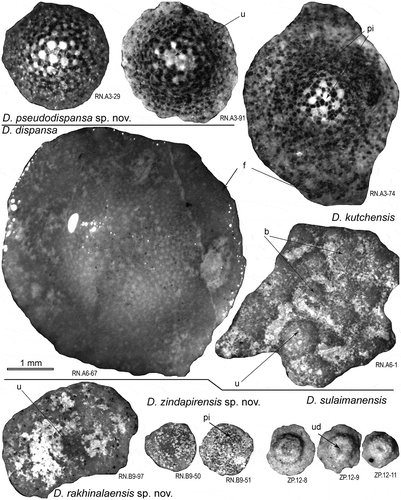
Figure 10. External test features of Discocyclina nandori, D. praeomphalus, and D. augustae from the Drazinda Formation. pi: piles, u: umbo, ud: umbonal depression, r: ribs.
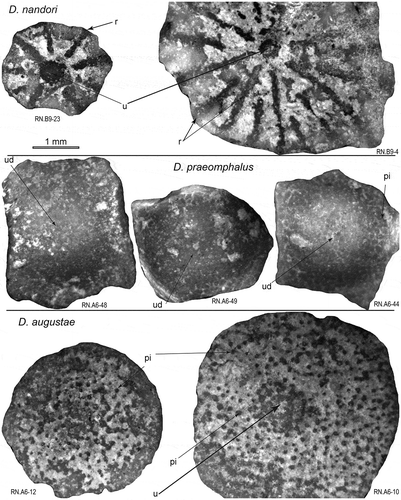
Figure 11. External test features of Discocyclina discus, and equatorial sections of microspheric forms of D. pseudodispansa sp. nov., D. kutchensis and D. augustae from the Drazinda Formation. pi: piles, u: umbo, f: flange.
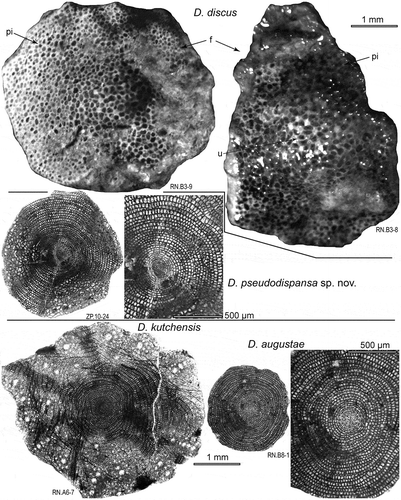
Figure 12. Axial sections of Discocyclina dispansa, D. pseudodispansa sp. nov., D. augustae, D. zindapirensis sp. nov., D. sulaimanensis, and D. rakhinalaensis sp. nov. from the Drazinda Formation. The axial section of D. dispansa (specimen FUL1-18) from the Fulra Limestone at its type-locality in Kutch Basin (India) is also illustrated for comparison.
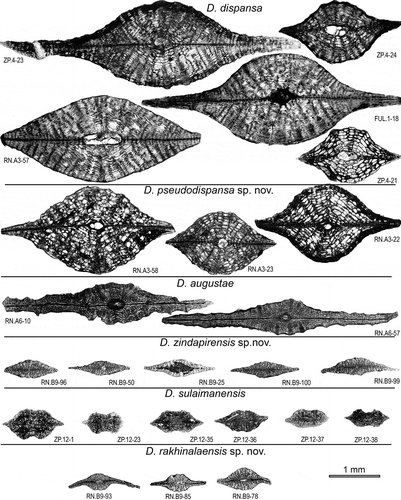
Figure 13. Comparison of the axial sections of Discocyclina sulaimanensis, D. zindapirensis sp. nov. and D. rakhinalaensis sp. nov. from the Drazinda Formation. P: protoconch, D: deutroconch, pi: piles, lcl: lateral chamberlets, eql: equatorial layer, ud: umbonal depression.
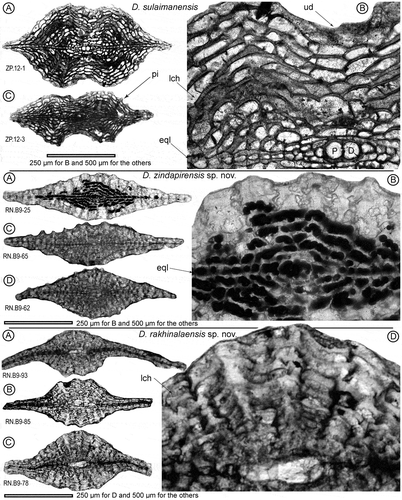
Figure 14. Axial sections of Discocyclina discus, D. praeomphalus, D. kutchensis, D. nandori and A. sireli from the Drazinda Formation.
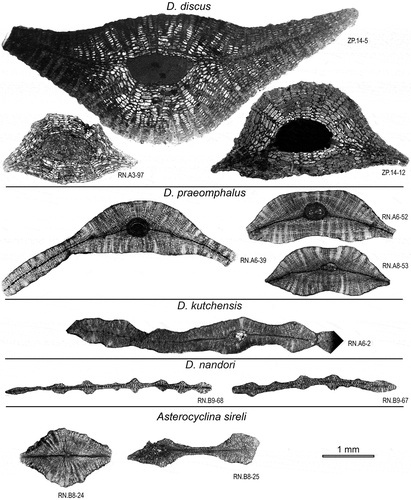
Figure 15. Equatorial sections of Discocyclina dispansa, and D. pseudodispansa sp. nov. from the Pirkoh and Drazinda formations.
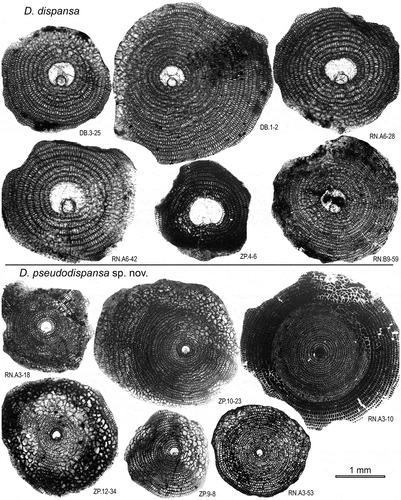
Figure 17. Equatorial sections of Discocyclina dispansa from the Pirkoh and Drazinda formations. Note that high early annuli are followed by lower and narrower ones. The sections do not illustrate the complete ontogeny.
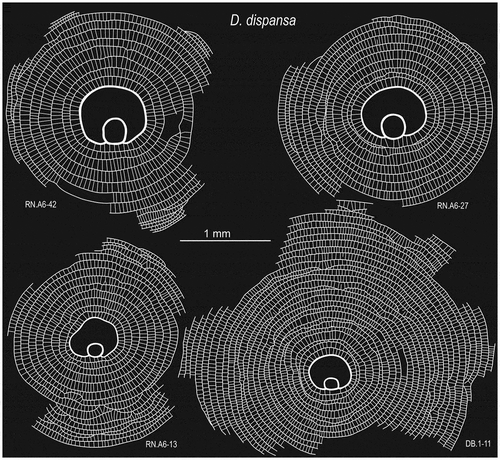
1840 Lycophris dispansus n. sp., Sowerby, p. 327, pl. 24, figs. 16, 16a–b.
1926 Discocyclina undulata sp. nov., Nuttall, p. 160−151, pl. 7, figs. 8–9, pl. 8, fig. 5.
Diagnosis. Discocyclina dispansa is a small to large sized, ‘flat to saddle’ shaped, unribbed form. The small to medium-sized megalospheric embryon is semi-nephrolepidine in the earliest representatives of its lineage (e.g. D. d. broennimanni and D. d. taurica) and is trybliolepidine in the phylogenetically advanced members. The adauxiliary chamberlets are moderately wide and high, and of the ‘archiaci’ type. The equatorial chamberlets are also moderately wide and high. This species includes six subspecies in Western Tethys: D. d. broennimanni Less, Citation1987 (Dmean < 160 μm); D. d. taurica Less, Citation1987 (Dmean = 160–230 μm); D. d. hungarica Kecskeméti, 1959 (Dmean = 230–290 μm); D. d. sella (d’ Archiac, Citation1850) (Dmean = 290–400 μm); D. d. dispansa (Sowerby, Citation1840) (Dmean = 400–520 μm); and D. d. umbilicata (Deprat, Citation1905) (Dmean > 520 μm) (Less, Citation1998).
Remarks. Discocyclina dispansa, one of the most common orthophragminid species in the middle Eocene of the Sulaiman Range and the Indian Subcontinent, was first described from the Fulra Limestone in Kutch Basin, India (Sowerby, Citation1840). At its type-locality, the species is invariably characterized by flat and thick forms (unpublished data of Ercan Özcan) (). In the Sulaiman Range, the species is represented by flat forms with a thick umbo, surrounded by a thin flange. The equatorial layer consists of a large trybliolepidine-type embryon (ranging in diameter from 399 to 664 μm in average), high equatorial chamberlets in the early stage (Figures ), followed by lower and narrower ones in the gerontic stage of development (). In axial sections, the embryon is about 225 (protoconch) to 250 (deuteroconch) μm in height (). The equatorial layer is about 30–35 μm thick. The lateral chambers are wide (180–320 μm) and high (50–90 μm). It appears that in the Western Tethys, saddle-shaped and flat forms exhibiting the ‘similar’ embryonic configuration and development of equatorial chambers appear to have been lumped under this species (Less, Citation1987; Özcan, Less, Báldi-Beke, Kollányi, & Kertesz, Citation2006). The notable overlaps in the ranges of some subspecies such as D. dispansa hungarica and D. dispansa sella in the Lutetian and Bartonian (Zakrevskaya, Beniamovsky, Less, & Báldi-Beke, Citation2011), and D. dispansa sella and D. dispansa dispansa in the Bartonian (Less, Özcan, & Okay, Citation2011) also may suggest lumping of forms with similar internal features. Based on biometry, this species is represented by D. d. dispansa (Sowerby, Citation1840) and D. d. umbilicata (Deprat, Citation1905) in our material. We think that a revision of this group is necessary and a taxonomic dictinction between the flat and saddle discocyclinids might be possible and hence, we here do not apply the subspecies concept to D. dispansa in the Sulaiman Range.
Discocyclina undulata was described for thick, flat discocyclinid specimens with a prominent umbo and a large embryon, about 440–770 μm in diameter, from the ‘lower part of middle Kirthar series’ in Sulaiman Range (east of Garmaf) in Pakistan (Nuttall, Citation1926). The species was named after the irregularly curved lateral chamberlet walls. Nuttall reported about 14 cycles of equatorial chambers in 1 mm distance from the embryon, which corresponds to 7 cycles in 0.5 mm distance. Samanta (Citation1969) studied the type-material and observed that embryon is characterized by a small protoconch and large deuteroconch exhibiting eulepidine- type configuration (this author also considers D. dispansa embryon as of eulepidine-type). Samanta also noted that in the middle part of the equatorial chamber cycles the annuli is narrower that the earlier ones. The axial sections illustrated by Nuttall show a great resemblance to that of. D. dispansa and D. pseudodispansa ( specimens ZP.4-24, ZP.4-21). We conclude that D. undulata is a junior synonym of D. dispansa based on (a) the similarities of test features, (b) embryon diameters, (c) number of equatorial chamber cycles within 0.5 mm distance from the embryon and, (d) narrowing of the annular chambers in the middle part of the equatorial layer.
Discocyclina pseudodispansa sp. nov. Özcan, Ali & Yücel
(Figures )
Diagnosis. Flat test, small-to medium-sized, strongly inflated with a thick umbo. The small embryon consists of a rounded to nearly-rounded protoconch and larger deuteroconch displaying semi-nephrolepidine to trybliolepidine type configuration in equatorial sections. The annuli are typically narrow, presenting ‘archiaci’ type growth pattern. The piles are coarser in the umbonal part, compared to flange. Moderately high and wide lateral chamberlets are arranged in irregular rows.
Derivation of the name. After the similaritiy of test shape and axial sections to D. dispansa.
Holotype. Specimen RN.A3-10, a megalospheric form ().
Paratypes. Specimens illustrated in Figures and .
Type locality. Rakhi Nala, Dera Ghazi Khan, Punjab, Pakistan.
Type level. Bartonian, lower-middle part of the Drazinda Formation, about 50 km west of Dera Ghazi Khan, Punjab.
Material. Megalospheric and microspheric specimens from samples Rakhi Nala and Zinda Pir sections.
Geographic and stratigraphic distribution. As yet, only known from the Bartonian of Pakistan.
Repository. The holotype and a single paratype (RN.A3-58), marked by TTM.P.I-2017/1 and TTM.P.I-2017/2 respectively, are deposited in Natural History Museum in General Directorate of Mineral Research and Exploration of Turkey, Ankara.
Description
External features. The test is typically flat, small to medium sized (1.35–6.8 mm in diameter) with a thick umbo, surrounded by a narrow, thin flange (). The thickness of the test varies between 600 and 2100 μm. The piles are relatively larger along the rims of the umbo (80–160 μm) compared to those in the flanges (50 μm), and are evenly distributed over the test surface.
Internal features. The embryon is small to moderately large, with average protoconch and deuteroconch diameters ranging between 81.6 and 106.2 and 190 and 252.3 μm respectively (). It exhibits semi-nephrolepidine to trybliolepidine configuration. The equatorial layer consists of low chambers (annuli), circular or near circular in outline. The chamberlets are typically square in shape, while those around the periphery may occasionally reach up to 130 μm and are rectangular in shape.
Axial section. The embryon is about 140 (protoconch) to 170 (deuteroconch) μm in height (). The equatorial layer is about 25–30 μm thick in the early stage and becomes 45–50 μm thick at the periphery. The lateral chambers are wide (180–250 μm) and high (50–85 μm).
Microspheric generation. The microspheric forms are common and display a typical discocyclinid juvenarium ().
Remarks. D. pseudodispansa sp. nov., a common species in the Sulaiman Range, could be easily confused with D. dispansa on the basis of external characters. This species, however, differs from D. dispansa in having a much smaller embryon and tighter early chambers (compare the n0.5 parameters of both species in ). The axial sections of both species are also similar to each other in terms of development of lateral chamberlets and their size (). In equatorial sections, some of the specimens exhibiting semi-nephrolepidine type of embryon may also be confused with D. augustae. The axial sections of both species are totally different as the lateral chamberlets in D. augustae are very low (slit-like) and small in size.
‘Discocyclina’ sulaimanensis Özcan, Ali & Hanif, 2016
(Figures )
Figure 18. Equatorial sections of Discocyclina rakhinalaensis sp. nov., D. zindapirensis sp. nov. and D. sulaimanensis and D. augustae from the Drazinda Formation.
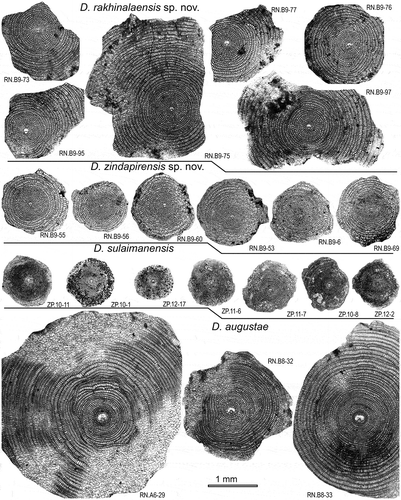
Figure 19. Comparison of embryon and equatorial chamberlets in Discocyclina rakhinalaensis sp. nov., D. zindapirensis sp. nov. and ‘D’. sulaimanensis from the Drazinda Formation.
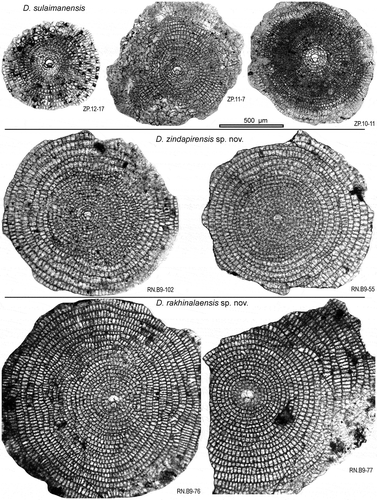
Figure 20. Comparison of embryon and equatorial chamberlets in Discocyclina rakhinalaensis sp. nov., D. zindapirensis sp. nov. and ‘D’. sulaimanensis from the Drazinda Formation.
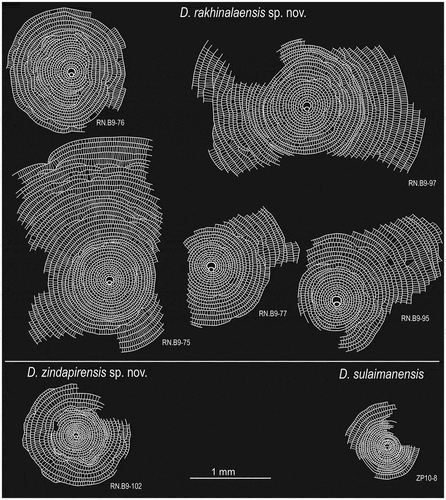
2016 ‘Discocyclina’ sulaimanensis sp. nov. Özcan, Ali, Hanif, p. 274–277, figs. 11–15, 16A–C.
Diagnosis. The omphaloid test is of small size, strongly inflated with a thick centrally- depressed umbo and an elevated ring-like structure. The small embryon consists of a rounded to nearly rounded protoconch and semi-rounded slightly larger deuteroconch displaying a semi-isolepidine or nephrolepidine type configuration in equatorial sections. The pre-annular stage is characterized by notably large auxiliary chambers, elongated parallel to the common axis of embryonic chambers, and only few (commonly single) isolated adauxiliary chamberlets. The annuli are typically narrow in the early, and high in the late stage, and present a ‘trabayensis’ type growth pattern. The septula are occasionally irregular and/or incomplete and partly in alignment in successive annuli. The equatorial chamberlets display annular and radial stolons, the former one being situated both on the proximal and distal side of the septulum. The piles (pillars) are coarser in the umbonal part, compared to flange. Moderately high and wide lateral chamberlets are arranged in irregular rows.
Remarks. ‘D’. sulaimanensis has a small test (700–1300 μm diameter), small embryon (deuteroconch diameter varying 50 to 75 μm), two large auxiliary chamberlets and few adauxiliary chamberlets. It differs from other omphaloid taxa from the Tethyan and Caribbean provinces in having a much smaller flat test, a more pronounced umbonal depression (Figures , and ), a smaller embryon (Figures and ), and a completely different development of early chambers () (Özcan et al., Citation2016). It shows some resemblance to some Caribbean orthophragminids, such as species of Proporocyclina Vaughan and Cole, 1941, in having irregular and/or incomplete septula in the early chambers. Such irregular/incomplete septula have never been recorded in Western Tethys and have a generic-level significance in the classification of Caribbean orthophragminids. Septula are absent in Athecocyclina (Vaughan, Citation1929) and incomplete and/or irregular in Proporocyclina (Caudri, Citation1996). As yet, the species is known only from the Sulaiman Range.
Discocyclina rakhinalaensis sp. nov. Özcan, Ali & Yücel
(Figures )
Diagnosis. Test of small size, discoid, with a thick umbo. The small embryon consists of a rounded to nearly rounded protoconch and semi-rounded slightly larger deuteroconch displaying a semi-isolepidine or nephrolepidine type configuration in equatorial sections. The adauxiliary chamberlets are of archiaci-type. The annuli are typically narrow in the early, and high in the later stages, and present a ‘trabayensis’ type growth pattern. The equatorial chamberlets are square in shape in the early stage and rectangular in the later stages. The piles are coarser in the umbonal part, compared to flange. Moderately high and wide lateral chamberlets are arranged in regular rows.
Derivation of the name. Named after Rakhi Nala in the Sulaiman Range, the type-locality of the species.
Holotype. Specimen RN.B9-75, a megalospheric form (Figures ).
Paratypes. Specimens illustrated in Figures and .
Type locality. Rakhi Nala, Dera Ghazi Khan, Punjab, Pakistan.
Type level. Bartonian, lower-middle part of the Drazinda Formation, about 50 km west of Dera Ghazi Khan, Punjab.
Material. Megalospheric specimens from section Rakhi Nala B.
Geographic and stratigraphic distribution. Known as yet only from the Bartonian of Pakistan.
Repository. The holotype and a single paratype (RN.B9–85), marked by TTM.P.I-2017/3 and TTM.P.I-2017/4 respectively, are deposited in Natural History Museum in General Directorate of Mineral Research and Exploration of Turkey, Ankara.
Description
External features. The test is typically small (980–3250 μm in diameter) with a thick umbo, surrounded by a narrow, thin flange (Figures and ). The thickness of the test varies between 350 and 450 μm. The piles are relatively larger along the rims of the umbo (50 μm) compared to those in the flanges (20 μm), and are evenly distributed over the test surface.
Internal features. The embryon is small with average protoconch and deuteroconch diameters of 64.2 and 102.8 μm respectively (). It exhibits semi-isolepidine or nephrolepidine type configuration. The archiaci-type adauxiliary chamberlets are low and narrow and their number ranges between 9 and 13. The equatorial layer consists of low chambers (annuli), circular or near circular in outline. The chamberlets are typically square in shape, progressively become higher, and those around the periphery may occasionally reach up to 85 μm and are rectangular in shape.
Axial section. The embryon is about 55–60 μm in height (). The equatorial layer is about 20–25 μm in thickness and it maintains throughout the ontogeny. The lateral chambers are 55–60 μm wide and 15–25 μm high.
Microspheric generation. The microspheric form is not known.
Remarks. D. rakhinalaensis, a rare species in the Sulaiman Range, is close to D. augustae in having a similar type of embryon and development of equatorial chambers. It differs from the latter by its small test size, general test features in axial sections and small embryon. This species differs from D. trabayensis of the peri-Mediterranean region in the type of adauxiliary chamberlets and much smaller embryon.
Discocyclina zindapirensis sp. nov. Özcan, Ali & Yücel
(Figures )
Diagnosis. Test of small size, flat, lenticular. The small embryon consists of a rounded to nearly-rounded protoconch and a sub-rounded slightly larger deuteroconch displaying a semi-isolepidine to nephrolepidine type configuration in equatorial sections. The annuli are typically narrow in the early, and high in the later stages, and present a ‘trabayensis’ type growth pattern. The equatorial chamberlets are square in shape in the early stage and rectangular in the later stages. The piles are of uniform size. Moderately high and wide lateral chamberlets are arranged in regular rows.
Derivation of the name. After Zinda Pir anticline in Sulaiman Range.
Holotype. Specimen RN.B9-102, a megalospheric form (Figures and ).
Paratypes. Specimens illustrated in Figures and .
Type locality. Rakhi Nala, Dera Ghazi Khan, Punjab, Pakistan.
Type level. Bartonian, lower-middle part of the Drazinda Formation, about 50 km west of Dera Ghazi Khan, Punjab.
Material. Megalospheric specimens from Rakhi Nala section.
Geographic and stratigraphic distribution. Known as yet only from the Bartonian of Pakistan.
Repository. The holotype and a single paratype (RN.B9-100), marked by TTM.P.I-2017/5 and TTM.P.I-2017/6 respectively, are deposited in Natural History Museum in General Directorate of Mineral Research and Exploration of Turkey, Ankara.
Description
External features. The test is typically small (1.15–1.5 mm in diameter), flat and slightly biconvex (Figures and ). The thickness of the test varies between 225 and 370 μm. The piles are relatively small (30–35 μm), uniformly distributed over the test surface.
Internal features. The embryon is small with average protoconch and deuteroconch diameters of 44.0 and 70.0 μm respectively (). It exhibits semi-isolepidine or nephrolepidine type configuration. The adauxiliary chambers are low and narrow and their number ranges between 4 and 5. The equatorial layer consists of low chambers (annuli), circular or near circular in outline. The chamberlets are typically square in shape, progressively become higher, and those around the periphery may occasionally reach up to 70 μm and are rectangular in shape.
Axial section. The embryon is about 40 μm in height (). The equatorial layer is about 25–35 μm thick throughout the ontogeny. The lateral chambers are 50–55 μm wide and 15–20 μm high.
Microspheric generation. The microspheric form is not known.
Remarks. D. zindapirensis, differs from D. rakhinalaensis in the shape of the test with distinct umbo, in having a smaller embryon, and few number of adauxiliary chamberlets. This species differs from D. trabayensis of the peri-Mediterranean region in the type of adauxiliary chamberlets and the smaller embryon.
Discocyclina kutchensis Özcan & Saraswati, 2016
(Figures )
Figure 22. Equatorial sections of Discocyclina kutchensis and D. nandori from the Drazinda Formation.
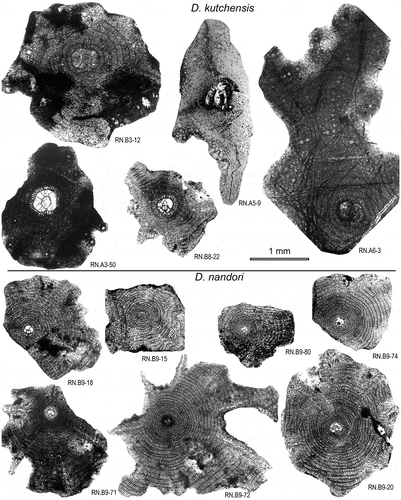
Figure 23. Comparison of embryon and equatorial chamberlets in Discocyclina kutchensis, D. nandori and D. praeomphalus from the Drazinda Formation.
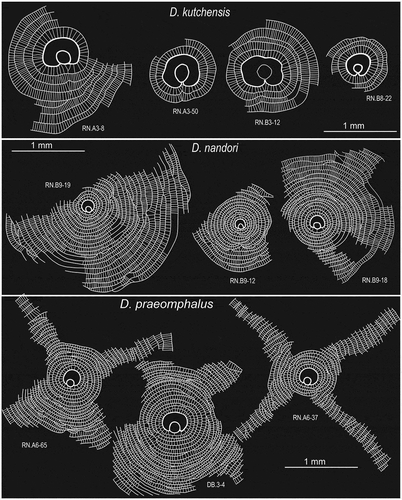
2016 Discocyclina kutchensis sp. nov. Özcan & Saraswati, pp. 267−274, figs 5L, 6A−I, 7A, 8A−D, 9, 10A−D.
Diagnosis. Medium sized (2 to 6 mm), flat forms with numerous bulges. The bulges, uniformly distributed over the test surface, are semi-rounded and rounded in shape and range in size between 250 and 350 μm. The embryon is large, with an average diameter of the deuteroconch ranging between 410 and 478 μm, trybliolepidine to umbilicolepidine in configuration. The adauxiliary chamberlets (37–53 in number) are high and archiaci-type. The equatorial chambers are typically high, narrow and rectangular in shape.
Remarks. This species, originally described from the Fulra Limestone in Kutch Basin in India, differs from all other orthophragminids in Tethys by having the bulges uniformly distributed on the test surface. The bulges are semi-rounded to rounded, localized thickenings, homogenously distributed over the test surface (CitationÖzcan et al., 2016). These structures are about 250–350 μm in diameter, 100–150 μm high and 100–300 μm apart from each other, and form an uneven test surface. Internally, the bulges consist of lateral chamberlets and coarse piles of up to 100 μm in diameter at its center, surrounded by smaller piles (25–50 μm in diameter), forming a circular pattern. These piles are semi-circular to polygonal in shape in transversal sections. The lateral surfaces of the bulges are rather sharp. The axial sections show no variation in the thickness of the equatorial layer adjacent to the bulges and inter-bulge areas. This implies that bulges are formed solely by the thickenings in the lateral layers (). Although bulges and ribs are easily distinguished from each other externally, a distinction between these structures is virtually impossible from axial sections. D. kutchensis is known from the Fulra Limestone in India and from the Drazinda Formation in the Sulaiman Range (CitationÖzcan et al., 2016).
Discocyclina praeomphalus Samanta & Lahiri, Citation 1985
(Figures )
Figure 24. Embryon and equatorial chamberlets in Discocyclina praeomphalus and D. discus from the Drazinda Formation.
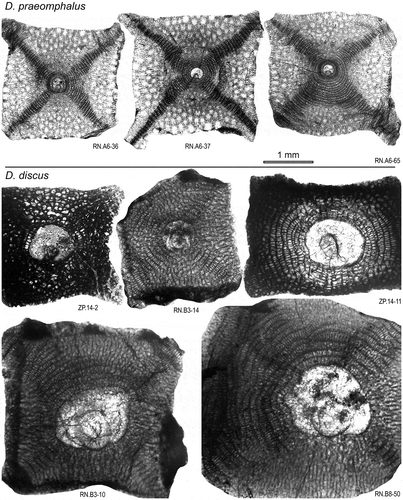
1985 Discocyclina praeomphalus n. sp. Samanta & Lahiri, p. 272−275. pl. 5, figs. 1–6, text figures 5–7, 12.
Diagnosis. Discocyclina praeomphalus is a medium sized (2.4–4 mm), saddle shaped, unribbed form with a slight depression at the center of the test. The megalospheric embryon (average 255.0–287.5 μm in diameter) exhibits semi-nephrolepidine to trybliolepidine type configuration. The adauxiliary chamberlets (16–29 in number) are moderately wide and high, and of the ‘archiaci’ type. The equatorial chamberlets are low and narrow in the early stage and are rectangular in shape in the later stages. The lateral chambers are typically low, numerous and not aligned in regular rows.
Remarks. This saddle-shaped, omphaloid species, first described from the Bartonian Fulra Limestone of the Kutch Basin, India (Samanta & Lahiri, Citation1985), is recorded here for the first time from Pakistan. It differs externally from other orthophragminids from the Drazinda Formation by its characteristic saddle shape and the central depression of the test (Figures and ). ‘D’. sulaimanensis, the other omphaloid species from the Drazinda Formation, has a flat and smaller test than that of D. praeomphalus. The axial sections of D. praeomphalus are easily differentiated from that of the saddle-shaped D. discus in having very low (slit-like) chamberlets (). This is a common discocyclinid in the middle Eocene of the Indian Subcontinent.
Discocyclina augustae van der Weijden, Citation 1940
(Figures )
1940 Discocyclina augustae n. sp. van der Weijden, p. 23−26, pl. 1, figs. 4, 5, 7, 8; pl. 2, figs. 1, 2, 11.
Diagnosis. Discocyclina augustae is an unribbed form having a very small to small, semi-iso- to nephrolepidine embryon, narrow and low, ‘archiaci’ type adauxiliary chamberlets and also narrow and relatively low equatorial chamberlets mostly with ‘strophiolata’ type growth pattern. This species includes four subspecies in Western Tethys: D. a. sourbetensis Less, Citation1987 (Dmean < 145 μm); D. a. atlantica Less, Citation1987 (Dmean = 145–180 μm); D. a. olianae (Almela & Rios, Citation1942) (Dmean = 180–225 μm); D. a. augustae van der Weijden, Citation1940 (Dmean > 225 μm).
Remarks. Discocyclina augustae, recorded here for the first time from Pakistan, is easily differentiated externally by its flat test with small central umbo and uniformly distributed piles (). It can be, however, easily confused with D. pseudodispansa sp. nov. in equatorial sections, whereas their axial sections are completely different (see the comparison in ). This species has a much larger embryon that that of D. rakhinalaensis sp. nov. In the studied material, D. augustae is represented by transitional stages between D. a. atlantica and D. a. olianae, according to the evolutionary scheme of the genus in the Western Tethys.
Discocyclina nandori Less, Citation 1987
(Figures )
1987 Discocyclina nandori n. sp. Less, p. 169−170, pl. 16, figs. 8–12, text-figures 27y–z.
Diagnosis. Discocyclina nandori is a ribbed form with a small, semi-nephro- to trybliolepidine embryon (less than 200 μm), rather few, moderately wide and average-sized, ‘pratti’ type adauxiliary chamberlets and narrow equatorial chamberlets with ‘trabayensis–pulcra’ type growth pattern. The equatorial chambers are low near the embryon and high at the peripheries.
Remarks. D. nandori, first recorded from the Amravati Formation in Cambay Basin in India by Özcan et al. (Citation2016), is the only ribbed discocyclinid in the Sulaiman Range. D. nandori has a moderately small protoconch (70–100 μm) and deuteroconch (140–205 μm), exhibiting semi-nephrolepidine type (rarely trybliolepidine-type) configuration (Figures and ). The equatorial chamberlets are low and narrow in the early stage and rectangular in the later stages of development. The assignment of ribbed specimens to Actinocyclina from the Sulaiman Range by Eames (Citation1952b) and the Cambay Basin by Tewari (Citation1949) is invalid after Less (Citation1987) and Ferràndez-Cañadell (Citation1997), since the microspheric forms of these specimens have a typical discocyclinid juvenarium and also, in axial sections, their equatorial layer shows no enlargement in the ribs (Özcan et al., Citation2016).
Discocyclina discus (Rütimeyer, Citation 1850 )
(Figures , , and )
Figure 25. Embryon and equatorial chamberlets in Discocyclina discus from the Pirkoh and Drazinda formations.
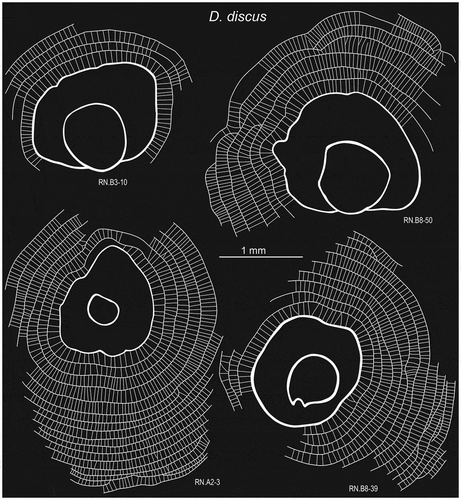
1850 Orbitolites discus n. sp. Rütimeyer, p. 116, pl. 5, figs. 70−71, 78, 80−81.
1926 Discocyclina sowerbyi nom. nov., Nuttall, p. 149−150, pl. 3, figs. 1–3.
2010 Lepidocyclina sp. (L. pustulosa), Matsumaru & Sarma, p. 550, pl. 3, fig 11.
Diagnosis. Discocyclina discus is an unribbed form with a giant, mostly umbilicolepidine (rarely also tryblio- or excentrilepidine) embryon, numerous, wide and high, ‘archiaci’ or transitional ‘archiaci-pratti’ type adauxiliary chamberlets and wide and high equatorial chamberlets with ‘archiaci’ or transitional ‘archiaci-pulcra’ type growth pattern. This species includes two subspecies in Western Tethys: D. d. discus (Rütimeyer, Citation1850) (Dmean < 1350 μm) and D. d. dudarensis Less, Citation1987 (Dmean > 1350 μm).
Remarks. D. discus, previously reported from the Drazinda Formation in the Sulaiman Range as D. sowerbyi, is distinguished from other orthophragminids by its thick, saddle-shaped test and its large embryon with irregular wall. D. praeomphalus, another saddle-shaped species, is much smaller and thinner than D. discus. In addition, the equatorial chambers of D. discus are much higher than those of D. praeomphalus (). Our data show that the thick, saddle-like forms described as Discocyclina sowerbyi (Nuttall, Citation1926) by Nuttall (Citation1926) and Sen Gupta (Citation1963) from the type locality of Lycophris ephippium of Sowerby (Citation1840) in the Kutch Basin, present the same morphological features as D. discus (Rütimeyer, Citation1850). Nuttall (Citation1926) proposed the specific name ‘sowerbyi’ to replace ‘ephippium’, which was preoccupied by another species. We maintain that D. sowerbyi, widely recorded from the middle Eocene of the Indian Subcontinent, is a junior synonym of D. discus. Matsumaru and Sarma (Citation2010) illustrated an axial section of a saddle-shaped specimen with a large and thick embryon from the late Eocene of Meghalaya (NE India) and identified it as a Caribbean Lepidocyclina sp. (L. pustulosa) without any illustration and description of the equatorial layer (Pl. 3, ). This was interpreted to be the first record of the genus in Meghalaya and significant for the occurrence of Caribbean lepidocyclinids in the Eocene of Indian Subcontinent. In our opinion, the illustrated axial section has the same morphological features of D. discus in having a large embryon, high and wide lateral chamberlets and saddle-shaped test (compare the axial section of the so-called Lepidocyclina with D. discus illustrated in Pl. 14), and cannot be referred to the genus Lepidocyclina.
Family Orbitoclypeidae Brönnimann 1946
Genus Asterocyclina Gümbel, 1870
Type species Asterocyclina stellata (d’ Archiac, Citation1846)
Asterocyclina sireli Özcan & Less, 2006
(Figure )
Figure 26. Comparison of embryon and equatorial chamberlets in Asterocyclina stellata and A. sireli from the Drazinda Formation.
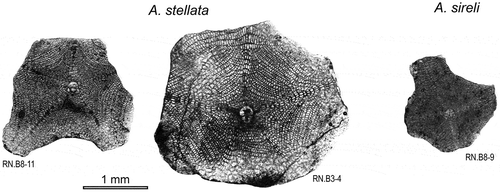
2006 Asterocyclina sireli n. sp. Özcan & Less, pl. 3, fig. 32; pl. 4, figs. 1–3; pl. 5, figs. 1–5; text-figure 12.
Diagnosis. Medium to large, flat forms with mostly four radial ribs and ‘marthae’ type rosette. The embryon is small, iso- to nephrolepidine. The deuteroconchal wall corresponding to the position of the successive stage of the developing rib is mostly depressed. The adauxiliary chamberlets are few (2–4) in number, low and moderately wide. The equatorial annuli are arranged usually in four rays.
Remarks. This species, recorded here for the first time from Pakistan, was first introduced from the Upper Lutetian of the Sivas Basin (Turkey) for asterocyclinid specimens displaying mostly four ribs and an embryon different from contemporaneous asterocyclinids in Western Tethys (Özcan et al., Citation2006). It was later recorded from the Bartonian Reineche Limestone in Tunisia and the Fulra Limestone in India (Ben İsmail-Lattrache et al., Citation2014). In its type material (sample ALM.6) from Sivas, twenty-two specimens out of twenty-five have four ribs. In lower Bartonian Reineche Limestone in Tunisia, only three specimens out of twenty-three specimens have five ribs. In the Fulra Limestone, only one out of seventy-nine specimens has five ribs and in the Drazinda Formation all specimens are with four ribs. The consistent occurrence of four ribs and the wide geographic range of this feature support that A. sireli is essentially a four-ribbed species. In contrast to its common occurrence in the Fulra Limestone, A. sireli is very rare in the Drazinda Formation. A detailed description of this species from India is given in Ben İsmail-Lattrache et al. (Citation2014).
Asterocyclina stellata ( Citation d’ Archiac, 1846 )
()
Diagnosis. Asterocyclina stellata is a star-shaped form usually with five rays and ‘marthae’ type rosette. It has a small semi-iso- to nephrolepidine-type embryon, few, wide and low, ‘stellata’ type adauxiliary chamberlets and also narrow and low equatorial chamberlets arranged into asteroidal annuli with ‘strophiolata’ type growth pattern. This species includes four subspecies in Western Tethys: A. s. adourensis Less, Citation1987 (Dmean < 150 μm); A. s. stellata (d’ Archiac, Citation1846) (Dmean = 150–190 μm); A. s. stellaris (Brünner, 1848 in Rütimeyer, Citation1850) (Dmean = 190–240 μm); A. s. buekkensis Less, Citation1987 (Dmean > 240 μm).
Remarks. A. stellata, recorded here for the first time from Pakistan, is very sporadic. In the Indian Subcontinent, this species has been previously recorded by Samanta (Citation1965) only from the Priabonian of Assam (India) as A. matanzensis Cole. A subspecies designation is not possible because of the rare specimens in the studied material.
6. Conclusions
The Bartonian orthophragminids in the Pirkoh and Drazinda formations are represented by two Tethyan genera, Discocyclina Gümbel, 1870 and Asterocyclina Gümbel, 1870. The former is very common and the latter is sporadic. The morphological variation in the orthophragminid test, ranging from small, flat to large saddle-shaped forms, is high, providing a helpful criterion for the identifications. We observed that these externally distinct types also possess distinctive morphological features in the lateral layers (as observed in axial sections) and the equatorial layer. The correlation in the external and internal test features in the equatorial layer is also supported by the biometry (e.g. D. discus with a large and D. praeomphalus with a comparatively smaller embryon). A key for the identification of orthophragminids in the Pirkoh and Drazinda formations based on test shape (flat versus saddle-shaped), and test surface characteristics (ribs, bulges, umbonal depressions) and test size (small versus large) is shown in .
Figure 27. Identification chart of orthophragminids from the Sulaiman Range based on external test shape and corresponding equatorial sections. The flat orthophragminids are categorized into four groups based on test surface features (e.g. ribs, bulges, and central depression of the test). The flat specimens with smooth test surface are further categorized as ‘small’ (<3 mm) and ‘large’ (>3 mm). The saddle-shaped tests are subdivided into two categories as ‘smooth tests’ and tests with ‘umbonal depression’. This categorisation does not reflect a taxonomical hierarchical classification.
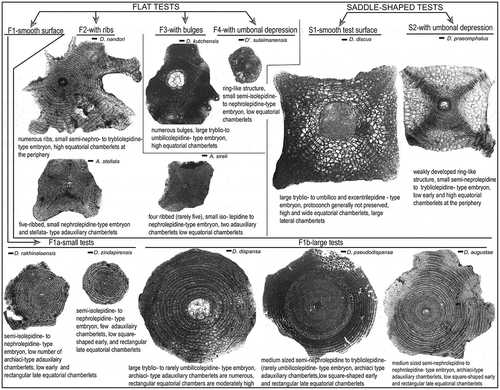
The saddle-shaped specimens are represented either by large, robust tests with large trybliolepidine-to umbilicolepidine-type embryon (D. discus) or comparatively small tests with omphaloid structure, characterized by the central depression on either side of the test with small, semi-nephrolepidine/trybliolepidine-type embryon (D. praeomphalus) (). The flat specimens are categorised into four groups as smooth tests (Discocyclina rakhinalaensis sp. nov., D. zindapirensis sp. nov., D. dispansa, D. pseudodispansa, D. augustae), test with ribs (D. nandori, Asterocyclina stellata, A. sireli), test with bulges (Discocyclina kutchensis), and omphaloid tests (D. sulaimanensis). The flat tests with smooth surface further can be categorised as small tests (<3 mm) or large tests (>3 mm) with various embryonic configurations. It is possible that some species, such as D. pseudodispansa and D. augustae, may be confused in the equatorial sections, although the external test shapes and test features in axial sections of both species are completely different. We also conclude that D. dispansa, characterized only by flat forms at its type-locality in Kutch Basin in India, is also represented invariably by flat specimens in Sulaiman Range. In Western Tethys, saddle-shaped and flat forms exhibiting ‘similar’ embryonic configuration and development of equatorial chambers appear to have been lumped under this species (Less, Citation1987; Özcan et al., Citation2006). The notable overlaps in the stratigraphic ranges of some subspecies of this species (Less et al., Citation2011; Zakrevskaya et al., Citation2011), also prompt the re-evaluation of this group in Western Tethys.
Our data suggest that a significant number of orthophragminid species from the Sulaiman Range, such as D. praeomphalus, D. sulaimanensis, D. kutchensis, and newly described D. rakhinalaensis, D. zindapirensis and D. pseudispansa, are endemic to Indian Subcontinent. A. sireli, common in eastern part of Western Tethys (e.g. Turkey), north Africa, and India, was not reported from central and western Europe. This implies a remarkable differentiation of orthophragminid taxa between the Indian Subcontinent and the peri-Mediterranean region already in (early) Bartonian times. The Ypresian and Lutetian orthophragminids from the Indian Subcontinent are poorly known. We encourage further research in Lutetian assemblages in Pakistan to evaluate the possible ancestral stocks of Bartonian orthophragminids and their relations to those in Western Tethys. This will help assessing whether some orthophragminid lineages in the Indian Subcontinent have independently developed during much of the Eocene or it followed a faunal differentiation period in Tethys that led to development of some endemic taxa. Our data are consistent with previous recent works (Ben İsmail-Lattrache et al., Citation2014; Özcan & Saraswati, Citation2014) postulating that generic and specific diversity of orthophragminids shows a longitudinal decline eastward from the peri-Mediterranean region. This relies on the fact that the common middle Eocene Orbitoclypeus and Nemkovella lineages have not been recorded in Pakistan. The number of asterocyclinid lineages may also show a decline eastward of the peri-Mediterranean region. We do not confirm the occurrence of Actinosiphon, a Paleocene Caribbean genus, and D. ranikotensis, early Eocene species endemic to Indian Subcontinent (Özcan, Hanif, Ali, & Yücel, Citation2015), in the Pirkoh and Drazinda formations.
Disclosure statement
No potential conflict of interest was reported by the authors.
Funding
This work was supported by the University of Peshawar.
Acknowledgements
We thank anonymous reviewers and editor Erdin Bozkurt for helpful suggestions in the review of the manuscript. We are grateful to the National Centre of Excellence in Geology, University of Peshawar for providing travel support for fieldwork in Pakistan. Prof. Dr. Tahir Shah, Dr. Irfan Ullah Jan and Dr. Muhammad Shafique were very kind in sharing their knowledge and assistance in regional geology and logistic.
References
- Abbas, G. (1999). Microfacies, depositional environments, diagenesis and porosity development in Limestone horizons of Kirthar Formation (Middle-Late Eocene) in frontal parts of Sulaiman fold belt and adjoining areas, Pakistan (PhD thesis). University of Punjab, 112 pp.
- Afzal, J., Asrar, M. K., & Naseer, A. S. (1997). Biostratigraphy of the Kirthar Formation (Middle to Late Eocene), Sulaiman Basin, Pakistan. Pakistan Journal of Hydrocarbon Research, 9, 15–33.
- Afzal, J., Wıllıams, M., & Aldrıdge, R. J. (2009). Revised stratigraphy of the lower Cenozoic succession of the Greater Indus Basin in Pakistan. Journal of Micropalaeontology, 8, 7–23.10.1144/jm.28.1.7
- Afzal, J., Wıllıams, M., Leng, M. J., Aldrıdge, R. J., & Stephenson, M. H. (2011). Evolution of Paleocene to Early Eocene larger benthic foraminifer assemblages of the Indus Basin, Pakistan. Lethaia, 44, 299–320.10.1111/let.2011.44.issue-3
- Almela, A., & Rios, J. M. (1942). Una nueva especie de Discocyclina del Eoceno Catalan. Instituto Geológico y Minero de España, 10, 57–64.
- Ben İsmail-Lattrache, K., Özcan, E., Boukhalfa, K., Saraswati, P. K., Soussi, M., & Jovane, L. (2014). Early Bartonian orthophragminids (foraminiferida) from Reineche Limestone, north African platform, Tunisia: Taxonomy and paleobiogeographic implications. Geodinamica Acta, 26, 94–121.
- Blanford, W. T. (1879). The Geology of Western Sind. Memoirs of the Geological Survey of India, 17, 1–210.
- Caudri, C. M. B. (1996). The Larger foraminifera of Trinidad (West Indies). Eclogae Geologicae Helvetiae, 89, 1137–1309.
- Charbonnier, S., Garassino, A., Pasini, G., Métais, G., Merle, D., Bartolini, A., … Marivaux, L. (2013). Early Paleogene decapod crustaceans from the Sulaiman and Kirthar Ranges, Pakistan. Annales de Paléontologie, 99, 101–117.10.1016/j.annpal.2012.12.003
- d’ Archiac, E. J. A. (1846). Description des fossiles recueillis par M. Thorent dans les couches à Nummulites des environs de Bayonne. Mémoires de la Société géologique de France, 2, 190–217.
- d’ Archiac, E. J. A. (1850). Description des fossiles du groupe nummulitique recueillis par M. S.-P. Pratt et M. J. Delbos aux environs de Bayonne et de Dax. Mémoires de la Société géologique de France, 2, 397–456.
- Deprat, J. (1905). Les dépots eocenes neo-calédoniens. Bulletin de la Societé géologique de France, 4, 485–516.
- Eames, F. E. (1952a). A contribution to the study of the Eocene in western Pakistan and western India: A. The geology of standard sections in the western Punjab and in the Kohat district. Quarterly Journal of the Geological Society, 107, 159–171.
- Eames, F. E. (1952b). A contribution to the study of the Eocene in western Pakistan and western India: D. discussion of the faunas of the certain standard sections, and their bearing on the classification and correlation of the Eocene in western Pakistan and western India. Quarterly Journal of the Geological Society, 107, 173–200.
- Ferràndez-Cañadell, C. (1997). A new, ribbed species of Nemkovella 1987 (Discocyclinidae), and discussion on the genus Actinocyclina Gümbel, 1870. Journal of Foraminiferal Research, 27, 175–185.10.2113/gsjfr.27.3.175
- Ferràndez-Cañadell, C. (1998). Morphostructure and paleobiology of Mesogean orthophragminids (Discocyclininidae and Orbitoclypeidae, Foraminifera). Acta Geologica Hispanica, 31, 183–187.
- Gingerich, P. D., Arif, M., Bhatti, M. A., Anwar, M., & Sanders, W. (1997). Basilosaurus drazindai and Basiloterus hussaini, new archaeoceti (mammalia, Cetacea) from the Middle Eocene Drazinda Formation, with a revised interpretation of ages of whale-bearing strata in the Kirthar group of the Sulaiman Range, Punjab (Pakistan). Contributions from the Museum of Paleontology, The University of Michigan, 30(2), 55–81.
- Gingerich, P. D., Ul-Haq, M., Khan, I. H., & Zalmout, I. S. (2001). Eocene stratigraphy and archaeocete whales (mammalia, Cetacea) of Drug Lahar in the Eastern Sulaiman Range, Balochistan (Pakistan). Contributions from the Museum of Paleontology, The University of Michigan, 30(11), 269–319.
- Hemphill, W. R., & Kidwai, A.H. (1973). Stratigraphy of the Bannu and Dera Ismail Khan areas, Pakistan. United States Geological Survey Professional Paper, 716-B, 36 pp.
- Hottinger, L. (2014). Paleogene larger rotalid foraminifera from the western and central Neotethys. Basel, Switzerland: Springer. 196 pp.
- Kazmi, A. H. & Abbasi, I. A. (2008). Stratigraphy and Historical geology of Pakistan. Pakistan: Department of Geology and National Centre of Excellence in Geology, University of Peshawar. 524 pp.
- Kazmi, A. H., & Rana, R. A. (1982). Tectonic map of Pakistan, 1: 2,000,000. Quetta: Geological Survey of Pakistan.
- Köthe, A., Khan, A. A., & Ashraf, M. (1988). Biostratigraphy of the Surghar Range, Salt Range, Sulaiman Range and the Kohat area, Pakistan, according to Jurassic through Paleogene calcareous nannofossils and Paleogene dinoflagellates. Geologisches Jahrbuch, B71, 1–87.
- Less, Gy. (1987). Paleontology and stratigraphy of the European Orthophragminae. Geologica Hungarica Series Palaeontologica, 51, 1–373.
- Less, Gy. (1998). Zonation of the Mediterranean Upper Paleocene and Eocene by Orthophragminae. Opera Dela Slovenska Akademija Znanosti in Umetnosti (4),, 34(2), 21–43.
- Less, Gy., Özcan, E., & Okay, A. I. (2011). Stratigraphy and larger foraminifera of the Middle Eocene to Lower Oligocene shallow-marine units in the northern and eastern parts of the Thrace Basin, NW Turkey. Turkish Journal of Earth Sciences, 20, 793–845.
- Matsumaru, K., & Sarma, A. (2010). Larger foraminiferal biostratigraphy of the lower Tertiary of Jaintia Hills, Meghalaya, NE India. Micropaleontology, 56, 539–565.
- Nagappa, Y. (1959). Foraminiferal biostratigraphy of the Cretaceous- Eocene succession in the India–Pakistan–Burma region. Micropaleontology, 5, 145–192.10.2307/1484208
- Neumann, M. (1958). Révision des Orbitoididés du Crétacé et de l’Eocène en Aquitaine occidentale. Mémoires de la Societé géologique de France (n. sér.), 37, 1–174.
- Nuttall, W. L. F. (1926). The zonal distribution and description of the larger foraminifera of the Middle and Lower Kirthar series (Middle Eocene) of parts of Western India. Records of the Geological Survey of India, 59, 115–164.
- Özcan, E., Ali, N., Hanif, M., Hashmi, S. I., Khan, A., Yücel, A. O., & Abbasi, I. A. (2016). New Priabonian Heterostegina from the Eastern Tethys (Sulaiman fold belt, West Pakistan): Implications for the development of Eastern Tethyan heterostegines and their paleobiogeography. Journal of Foraminiferal Research, 46(4), 393–408.
- Özcan, E., Hanif, M., Ali, N., & Yücel, A. O. (2015). Early Eocene orthophragminids (Foraminifera) from the type-locality of Discocyclina ranikotensis Davies, 1927, Thal, NW Himalayas, Pakistan: Insights into the orthophragminid paleobiogeography. Geodinamica Acta, 27, 267–299.
- Özcan, E., Less, Gy, Báldi-Beke, M., Kollányi, K., & Kertesz, B. (2006). Biometric analysis of middle and upper Eocene Discocyclinidae and Orbitoclypeidae (Foraminifera) from Turkey and updated orthophragmine zonation in the Western Tethys. Micropaleontology, 52, 485–520.
- Özcan, E., & Saraswati, P. K. (2014). Late Middle Eocene (Bartonian) orthophragminids from Fulra Limestone, Kutch Basin (western India): Regional implications and their correlation to well-known assemblages in western Tethys (north Africa, Europe and Turkey), Abstract volume, Earth Sciences Pakistan, Baragali Summer Campus, University of Peshawar. Journal of Himalayan Earth Sciences, 102, 66 p.
- Özcan, E., Saraswati, P. K., Hanif, M., & Ali, N. (2016). Orthophragminids with new axial thickening structures from the Bartonian of the Indian subcontinent. Geologica Acta, 14(3), 261–282.
- Portnaya, V.L. (1974). Discocyclinids from the Eocene deposits of the Crimea and their biostratigraphic significance. Moscow: Moscow State University. 175 pp. (in Russian).
- Racey, A. (1995). Lithostratigraphy and larger foraminiferal (nummulitid) biostratigraphy of the Tertiary of northern Oman. Micropaleontology, 41, 1–123.10.2307/1485849
- Rütimeyer, L. (1850). Ueber das schweizerische Nummulitenterrain mit besonderer Berücksichtigung des Gebirges zwischen den Thunersee und der Emme. Denkschriften der Schweizerischen Naturforschende Gesellschaft, 11, 1–120.
- Samanta, B. K. (1965). Asterocyclina from the Upper Eocene of Assam, India. Contributions from the Cushman Foundation for Foraminiferal Research, 16, 22–27.
- Samanta, B. K. (1968). The Eocene succession of Garo Hills, Assam, India. Geological Magazine, 105, 124–135.10.1017/S0016756800052493
- Samanta, B. K. (1969). Taxonomy and stratigraphy of the Indian species of Discocyclina (foraminifera). Geological Magazine, 106, 115–230.10.1017/S0016756800051931
- Samanta, B. K. (1973). Planktonic foraminifera from the Palaeocene-Eocene succession in the Rakhi Nala, Sulaiman Range, Pakistan. Bulletin of the British Museum (Natural History), 22, 421–482.
- Samanta, B. K., & Lahiri, A. (1985). The occurrence of Discocyclina Gümbel in the middle Eocene Fulra limestone of Cutch, Gujarat, Western India, with notes on species reported from the Indian region. Bulletin Geological Mining Metallurgical Society of India, 52, 211–295.
- Sameeni, S. J., Ahsan, N., & Baloch, Z. (1994). Micropaleontology of Pirkoh limestone of Eocene Kirthar Formation, Afiband area, Sulaiman province, Pakistan. Kashmir Journal of Geology, 11–12, 137–140.
- Schaub, H. (1981). Nummulites et Assilines de la Tethys Paléogène. Taxonomie, phylogénèse et biostratigraphie. Schweizerische Paläontologische Abhandlungen, 104–106, 1–236 + Atlas I–II.
- Schweitzer, C., Feldmann, R., & Gingerich, P. D. (2004). New decapoda (crustacea) from the Middle and Late Eocene of Pakistan and revision of Lobonotus A. Milne Edwards, 1864. Contributions from the Museum of Paleontology, The University of Michigan, 31(4), 89–118.
- Sen Gupta, B. K. (1963). A restudy of two common species of Discocyclina from India. Micropaleontology, 9(1), 39–49.10.2307/1484604
- Serra-Kiel, J., Hottinger, L., Caus, E., Drobne, K., Ferrández, C., Jauhri, A. K., … Zakrevskaya, E. (1998). Larger foraminiferal biostratigraphy of the Tethyan Paleocene and Eocene. Bulletin de la Societé géologique de France, 169, 281–299.
- Shah, S. M. I. (2009). Stratigraphy of Pakistan. Geological Survey of Pakistan Memoirs, 22, 381 pp.
- Sowerby J. de C. (1840). Systematic list of organic remains. Appendix to: Grant, C.W., Memoir to illustrate a geological map of Cutch. Transactions of the Geological Society of London, 5(2), 317–329.
- Tewari, B. S. (1949). On a stellate Discocycline from the Upper Eocene of Surat-Broach area (Bombay Presidency). Current Science, 18, 401.
- van der Weijden, W. J. M. (1940). Het genus Discocyclina in Europa. Een monografie naar aanleiding van een heronderzoek van het Tertiair-profiel van Biarritz (thesis). Leiden: Rijkuniversiteit. 116 pp.
- Vaughan, T. W. (1929). Descriptions of the new species of foraminifera of the genus Discocyclina from the Eocene of Mexico. U.S. National Museum Proceedings, 76, 1–18.
- Warraich, M. Y., & Nishi, H. (2003). Eocene planktic foraminiferal biostratigraphy of the Sulaiman Range, Indus Basin, Pakistan. Journal of Foraminiferal Research, 33(3), 219–236.10.2113/33.3.219
- Weiss, W. (1993). Age assignment of larger foraminiferal assemblages of Maastrichtian to Eocene age in Northern Pakistan. Zitteliana, 20, 223–252.
- Zakrevskaya, E., Beniamovsky, V., Less, Gy, & Báldi-Beke, M. (2011). Integrated biostratigraphy of Eocene deposits in the Gubs section (Northern Caucasus) with special attention to the Ypresian/Lutetian boundary and to the Peritethyan-Tethyan correlation. Turkish Journal of Earth Sciences, 20, 753–792.
- Zalmout, I. S., Ul-Haq, M., & Gingerich, P. D. (2003). New species of Protosiren (mammalia, Sirena) from the Early Middle Eocene of Balochistan (Pakistan). Contributions from the Museum of Paleontology, The University of Michigan, 31(3), 79–87.
- Zhang, Q., Willems, H., & Ding, L. (2013). Evolution of the Paleocene-Early Eocene larger benthic foraminifera in the Tethyan Himalaya of Tibet, China. International Journal of Earth Sciences, 102, 1427–1445.

